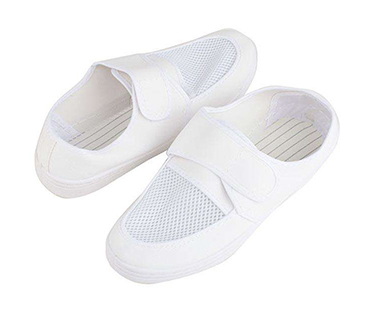Suzhou anti-static clothing to do anti-static shoes national standards.
National Standard for Anti-static Shoes of the People's Republic
.GB4385-1995 technical requirements for anti-static shoes and conductive shoes
.1 The power supply of the test instrument can output a DC voltage of 100V ± 2V.
The instrument's voltmeter and ammeter accuracy is 2.5, and the range can meet the measurement requirements.
A1.2 The inner electrode consists of a steel ball with a total weight of 4 kg and a diameter of 5 mm. It must be treated with anti-oxidation before use.
A1.3 The external electrode is a copper plate. It must be treated with anti-oxidation before use and cleaned with ethanol.
A2 test sample preparation
A2.1 Sample preparation
The surface of the sole of the shoe to be tested is cleaned with ethanol. The sole was washed with distilled water and allowed to dry under the conditions specified in A3.1. It is strictly forbidden to use organic substances that cause the sole to be corroded and swelled and deformed. The surface of the sole should not be subject to wear. A conductive layer with an area of 180 mm × 40 mm is applied to the cleaned sole as shown in Figure A1 and allowed to dry under the environmental conditions specified in A3.1.

A2.2.1 The device for measuring the resistance of the conductive coating consists of three conductive metal columns with a top radius of 3 mm ± 0.2 mm. Two of the columns are 35 mm ± 0.2 mm apart and connected by metal wires. The third column is 160 mm ± 5 mm from the midpoint of the other two column connections and is insulated from the other two columns.
A2.2.2 Place the conductive coated shoes on the metal column specified in A2.2.1. The forefoot portion of the shoe is placed on two posts 35 mm apart and the heel portion is placed on the third post, all of which must be in contact with the conductive coating. Then measure the resistance between the first two columns and the third column using the test instrument specified in A1.1. The circuit principle is shown in Figure A2. The measurement result must have a resistance of less than 1 kΩ.
Second, introduce the relevant standards of anti-static safety shoes
European Standard EN 344:1997 “Special Safety, Protection and Work Shoes”, which is developed by CEN/TC61 “Protective Products for Foot and Leg Protection” and its secretariat is operated by BSI. This standard specifies the structural design and performance indicators of safety shoes, such as shoes, uppers, shoes, tongues, insole and outsole. The test methods for each item specified in the standard are similar to other similar standards. The method principle is also generally applicable to most safety anti-static protective shoes. The main indicators are:
Baotou impact resistance
The impact test shall be carried out with a steel impact hammer of a specified weight. The height of the gap under the toe cap shall be less than the specified value when the toe cap is impacted, and the piercing shall not show any penetrating cracks in the direction of the test axis. It is worth noting that the national standards have different regulations on the weight, specifications, impact height and construction of the test machine. The actual test should be distinguished.
Puncture resistance
The test machine is equipped with a pressure plate on which the test nail is mounted. The test nail is a tip with a cut-off tip, and the hardness of the nail head should be greater than 60HRC. The sole sample is placed on the chassis of the testing machine in such a position that the test nail can be pierced through the outsole, and the test nail pierces the sole at a speed of 10 mm/min ± 3 mm/min until it is worn.
Record the maximum force required. Four points are selected on each sole for testing (at least one of which is at the heel), each point is not less than 30 mm apart, and the distance from the insole edge is greater than 10 mm. The bottom of the anti-slip block should be pierced between the blocks. Two of the four points should be tested within 10-15 mm of the edge line of the bottom of the plant. If humidity affects the results, the sole should be immersed in deionized water at 20 °C ± 2 °C for 16 ± 1 h before testing.
Electrical performance
After the shoe sample is adjusted in a dry and wet atmosphere, the clean steel ball is filled into the human shoe and placed on the metal probe device, and the first two probes and the third probe are measured using a prescribed resistance tester. Resistance between. Under normal circumstances, conductive shoes require resistance should not be greater than l00K ohms; anti-static shoes require resistance should be between 100K ohms and 100M ohms.
4 requirements for non-slip outsole
This standard stipulates the anti-skid coefficient of the anti-static work sole, but specifies the design and specifications of the anti-slip block, such as the thickness of the sole, the height of the non-slip block, and the distance from the edge of the sole.
Anti-static shoes storage
5.1 place
It should be stored in a dry and ventilated warehouse to prevent mildew. Stacked off the ground, wall more than 0.2M, leaving all heating elements 1M away. Avoid contact with oil, acids, alkalis or other corrosive materials.
5.2 deadline
Calculated from the date of production, products over 18 months shall be inspected in accordance with the provisions of 5.2 of this standard, and shall be sold and used in accordance with the requirements.
6 anti-static shoes use
A. Wear anti-static shoes and conductive shoes should not wear insulated wool stockings and insulated insoles at the same time. The place where the anti-static shoes are used shall be an anti-static floor, and the place where the conductive shoes are used shall be a conductive floor.
B. In the process of wearing, generally no more than 200H should be tested for resistance once.
 Service Hotline:18952406303
Service Hotline:18952406303
 URL:ssl-https.cn
URL:ssl-https.cn
 address:Room 101, 1st Floor, Phase III, Suzhou SEG Electronics Market, Binhe Road, Suzhou High-tech Zone
address:Room 101, 1st Floor, Phase III, Suzhou SEG Electronics Market, Binhe Road, Suzhou High-tech Zone
